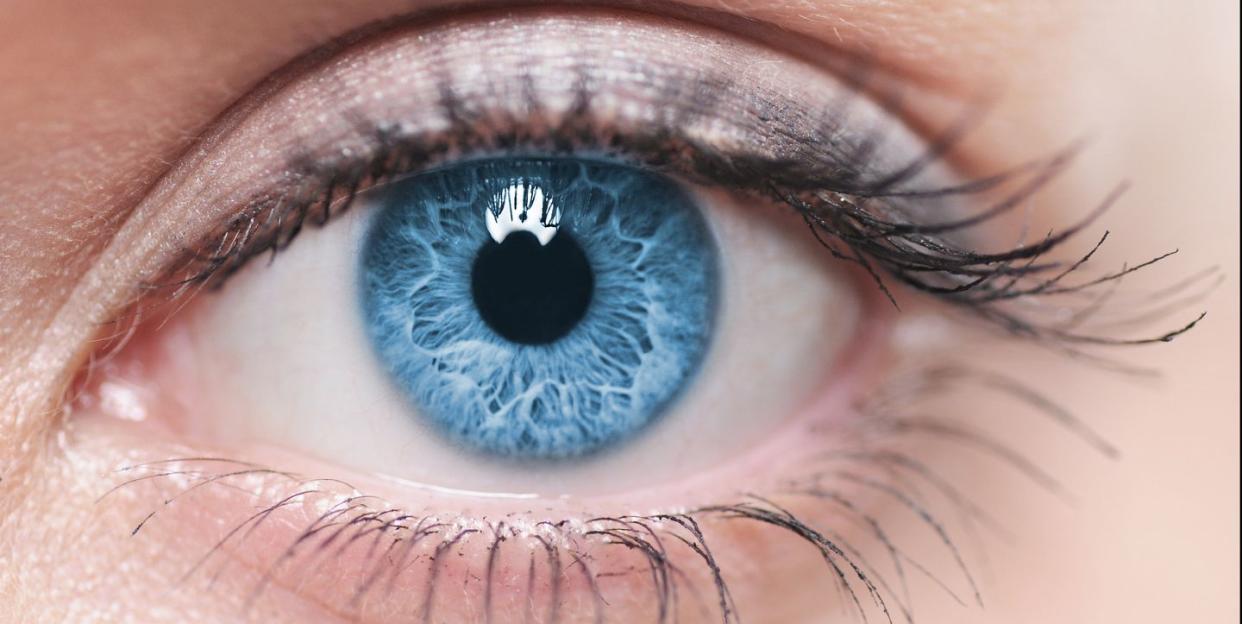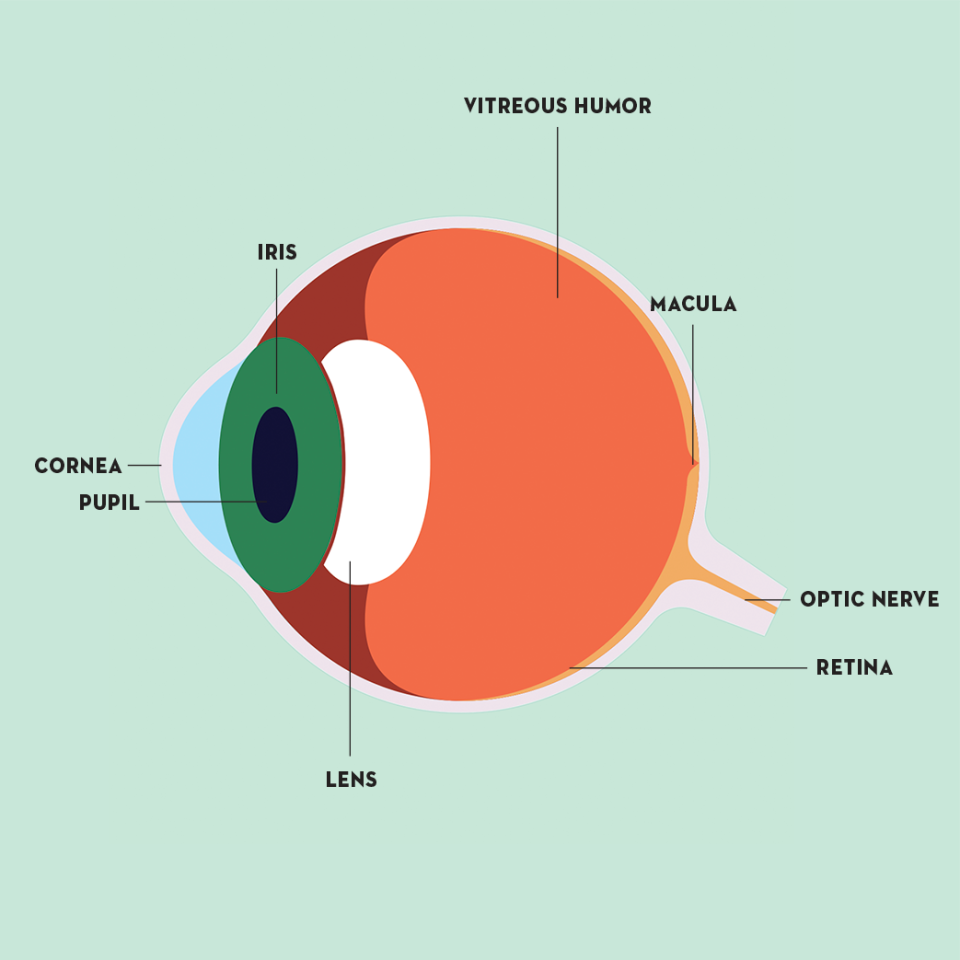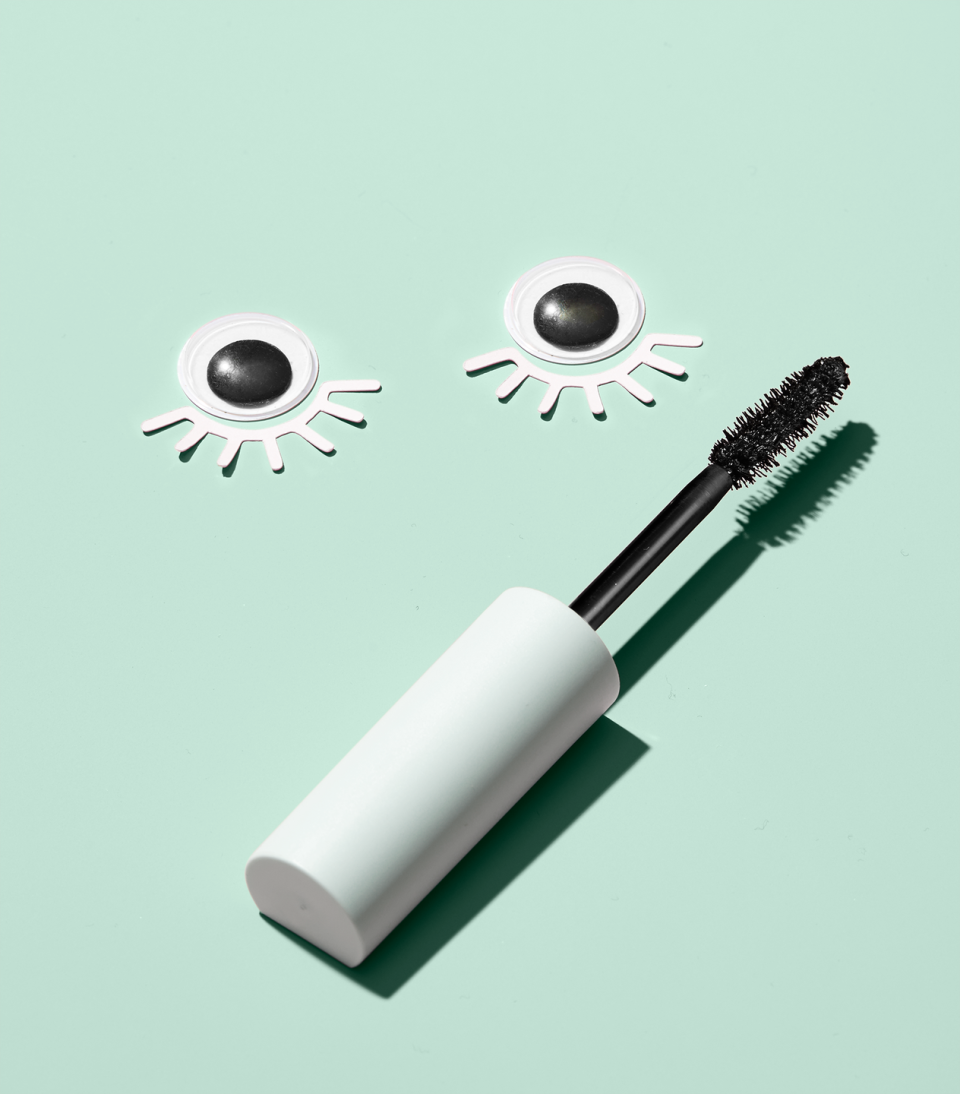It's True, Eating Carrots Will Help You Maintain Good Eye Health

The eyes are not only the windows to your soul: They may also provide pretty good insight into your overall health. In fact, changes your doctor detects in your eyes can flag conditions like diabetes, hypertension, rheumatoid arthritis, and maybe even your risk for Alzheimer’s — not to mention ocular diseases, which can sneak up on you.
An estimated 61 million of us are at high risk for serious vision loss, which ranks number one on the list of Americans’ worst health nightmares (it trumps fear of losing memory or even a limb), according to Johns Hopkins University researchers. "The eyes have many delicate parts, so they simply don’t age very well," says Irene Barbazetto, M.D., Ph.D., clinical instructor of ophthalmology at NYU Langone Health in New York City. That’s why regular checkups, including a dilated eye exam in which the ophthalmologist can look at your eyes’ inner workings, are key to spotting conditions that put you at risk.
Here, we're sharing more information about the most common ocular diseases that affect us today, plus a few tips from leading experts on how to safeguard your vision as you age. And you'll learn more about the magnificent process behind our vision as well.
These are the most common eye health concerns:
For optometrists and other healthcare experts alike, these degenerative vision issues often manifest in their patients as they age. Here's everything you should know about potential risks.
Refractive Errors: Ask anyone with glasses or contacts! These are simply garden-variety nearsightedness and farsightedness as well as astigmatism (distorted vision at all distances) and presbyopia, which is the loss of up-close focusing ability (hello, reading glasses!). These issues happen when the eye can’t properly bend light as it enters. The condition is often caused because we're just, well, human: Genetics, age, and gender can also play a role. Women over 40 years old experience 14% more refractive issues than men. The best way to combat this condition is by wearing the correct glasses, contact lenses, or for serious cases, laser surgery. The National Eye Institute says 11 million Americans aren't sufficiently corrected and would see a whole lot better if they were, so maybe ask your eye doctor about updating your prescription.
Cataracts: These occur when proteins in the lenses clump together into clouds, blurring your vision. “When people get old enough, almost everyone has a cataract,” says Dr. Barbazetto, who’s in private practice at Vitreous Retina Macula Consultants of New York. If you have spent a lot of time in the sun, take steroids, have diabetes or smoke or drink a lot, your risk is even higher. More often than not, a cataract can be detected during an eye exam with dilation, but you’ll likely notice it first: Colors will start to look faded, you’ll see a halo around natural light, or you won’t be able to see easily at night. If your cataract is small, try reading with a magnifying glass and using brighter lights at home and the office. If it gets too big, the cure involves outpatient surgery to swap an artificial lens in for the clouded one.
Macular Degeneration: The macula helps us see right in front of us — the person we’re talking to, cars ahead on the road, the text message we’re trying to read. With age-related macular degeneration (also known as AMD), which nearly 2 million Americans have, some sufferers may see a gray or black spot in the center, and some vision in the periphery. This occurs when the macula develops deposits as you age, causing early (also called “dry”) AMD, the most common type. The “wet” version occurs when the macula fills with leaky abnormal blood vessels. Aging and genetics are most to blame, but smoking also increases your risk. Treatments have been shown to slow progression and save sight, which is why it’s crucial to diagnose AMD early, Dr. Barbazetto says. Once you hit your mid- to-late 40s, you should have an eye exam every two years, or annually if you have a family history of AMD. Your doctor will dilate your pupils to look behind them. If early to intermediate AMD is diagnosed, you can take special vitamins packed with C, E, zinc, lutein and other nutrients to slow down the damage. Arresting the wet version requires regular injection of medicine into your eye (doctors do use a numbing agent first).
Glaucoma: Pressure buildup in the eye can cause damage to the optic nerve over time. Peripheral vision is affected first, but there's a chance that you may eventually develop total blindness. While anyone can develop glaucoma, age and genetics (especially if you’re African American or Hispanic/Latina) can up the odds. Be sure to see your eye doc for a checkup — half of those afflicted don’t know they have the disease. Although physicians may use a test in which a puff of air is blown into your eye for screening, official diagnosis requires a dilated exam to scrutinize the optic nerve as well as other tests. Medicine, lasers and/or surgery can keep the disease from worsening.
Diabetic retinopathy: Poor control of your blood sugar levels can lead to this condition, where high blood sugar levels damage retinal vessels over time. With so many cases of type 2 diabetes in the U.S., this is the leading cause of blindness in American adults. “People with diabetes can prevent this complication with strict glucose control,” says Elena Roth, M.D., a comprehensive ophthalmologist at Bascom Palmer Eye Institute in Miami. If you have diabetes, eat right, exercise, take all prescribed medications, check your blood sugar regularly and get a yearly dilated retinal exam. Lasers, injections and/or surgery can be effective, but only before the loss of sight, which is why early diagnosis is crucial, Dr. Roth says.

How your eyes actually work:
Let's say you happen upon a field of bright yellow daffodils. What you think of as your eye is just a tiny portion of the magical machinery that transforms what you're looking at into an image your brain understands.
Cornea: Sight begins here. Light bounces off the flowers and enters this transparent tissue on the orb's surface, and the cornea bends the light to make the image clearer.
Iris: The colored part of the eye (surrounded by the bright white sclera) doesn't just look beautiful — it's in charge of changing the size of the pupil.
Pupil: This opening in the iris's center widens to welcome light when it's dark and narrows to restrict light when there's too much, letting us glimpse those flowers at both daytime and dusk.
Lens: The light bends even more once it hits the lens, which is situated behind the iris. This structure controls focus, letting us take in the field from far away or a single blossom up close.
Vitreous Humor: Taking up most of the space between the back of the lens and the retina, this clear gel helps keep the eye rounded and nourished.
Retina: The light that comes in via the cornea and through the lens winds up at this tissue in the back. Here, photoreceptor cells (including rods and cones) transform light into electrical pulses. The tiny area in the center of the retina called the macula is responsible for our central vision, giving us the ability to see the flowers directly in front of us.
Optic nerve: The electrical signals travel through the million-plus fibers of this nerve to enter the brain, which identifies the pulses as those beautiful springtime blooms.

How you can keep your eyes healthy:
Experts say these lifestyle changes can help you keep your sight sharp over time.
Munch on veggies. Carrots, squash, and pumpkin are full of vitamin A, which is essential to eye health, Dr. Roth says, and dark leafy greens like spinach, kale, and collards are high in the eye-friendly antioxidant lutein.
Give up smoking. Quitting lowers the risk of not only lung and heart disease but also age-related macular degeneration, cataracts and optic nerve damage.
Wear shades. Even in winter, it’s important to protect your eyes from ultraviolet rays, which can lead to cataracts and some cancers. Look for large lenses and 99% to 100% blocking of both UVA and UVB radiation.
Grab goggles. Don safety goggles or eye guards for any sport using a ball or any time you are using a hammer, a nail gun or chemicals that might splash or are grinding metal (such as to make jewelry or home repairs). About 2,000 Americans injure their eyes each day at work, per the National Institute for Occupational Safety and Health, but experts believe that 90% of those injuries would be less severe or could be prevented with proper protection.
Fight allergies, and four other common issues:
Take care of these minor but uncomfortable eye issues the right way so you can stop seeing red ASAP.

Dry eyes and blurry vision: Intense watching of screens makes us forget to blink, which leads to these issues as well as headaches. You should try to use the 20-20-20 rule to relax and rewet your eyes: Every 20 minutes, look 20 feet in front of you for 20 seconds. A phone alert can help you remember. You'll also want to avoid setting your monitor so high that your eyes must be completely open to see it. Exposing more of your eyeballs to air speeds up evaporation of moisture, Dr. Bunya says.
Eye infections: Toss that too-old eye makeup! Bacteria in your eyes can result in redness, itching, swelling, discharge, pain and/or difficulty seeing. Contact lens wearers, who may introduce germs as they insert the lenses, are at high risk, says Vatinee Bunya, M.D., co-director of the Penn Dry Eye & Ocular Surface Center and assistant professor of ophthalmology at the University of Pennsylvania Perelman School of Medicine. You should replace your mascara every three months to keep it free of bacteria. And take out contacts at night, Dr. Bunya advises, even if they’re labeled for long-term wear — sleeping in them ups your risk tenfold because it gives bacteria time to multiply. And be sure to check if you have an infection with a proper visit: You may need prescription antibiotic drops from an eye doctor.
Pink eye: People commonly refer to any irritant they may experience this way, but the term properly refers to a contagious virus similar to the common cold that inflames the mucosal covering of the eye, Dr. Bunya says. Symptoms are telltale redness in the whites of the eyes or inside lids along with swelling, itching and crusty discharge. You'll have to stay away from work or school for seven to 10 days — until after symptoms have totally disappeared — or you could spread it, Dr. Bunya cautions. Wash your hands regularly and keep your fingers away from eyes. Don’t take antibiotics to treat it, because they don’t work on viruses and overuse of them contributes to dangerous drug resistance. Artificial tears may help until it clears up, but if the pain is severe or doesn’t get better, talk to your doctor.
Floaters: The clear gel behind the eye clumps together, allowing us to see it. The gel clumps aren’t usually dangerous, but if new floaters appear suddenly or you see sudden flashes of light or shadows, see your doctor so you can rule out a retinal tear. Leave it be: Your eye and brain will eventually adjust and you’ll stop noticing the floater, says Elena Roth, M.D., a comprehensive ophthalmologist at Bascom Palmer Eye Institute in Miami. Eye drops won't help floaters disappear, so you might just have to wait this one out.
You Might Also Like

